
FC Basel 1893, widely known as FC Basel, FCB, or just Basel, is a Swiss football club based in Basel, in the Canton of Basel-Stadt. Formed in 1893, the club has been Swiss national champions 20 times, Swiss Cup winners 12 times, and Swiss League Cup winners once.

Saint Ursula is a legendary Romano-British Christian saint who died on 21 October 383. Her feast day in the pre-1970 General Roman Calendar is 21 October. There is little information about her and the anonymous group of holy virgins who accompanied and, on an uncertain date, were killed along with her at Cologne. They remain in the Roman Martyrology, although their commemoration does not appear in the simplified Calendarium Romanum Generale of the 1970 Missale Romanum.

August Robert Ludwig Macke was a German Expressionist painter. He was one of the leading members of the German Expressionist group Der Blaue Reiter. He lived during a particularly active time for German art: he saw the development of the main German Expressionist movements as well as the arrival of the successive avant-garde movements which were forming in the rest of Europe. As an artist of his time, Macke knew how to integrate into his painting the elements of the avant-garde which most interested him. Like his friend Franz Marc and Otto Soltau, he was one of the young German artists who died in the First World War.
A Judensau is a folk art image of Jews in obscene contact with a large sow, which in Judaism is an unclean animal, that appeared during the 13th century in Germany and some other European countries; its popularity lasted for over 600 years.
Dionotus was a legendary king of Cornwall in Geoffrey of Monmouth's Historia regum Britanniae, an account of the rulers of Britain based on ancient Welsh sources and disputed by many historians. Dionotus succeeding his brother Caradocus, and was regent of Britain during the campaigns in Gaul of Emperor Magnus Maximus. The curious thing about this king is that the Welsh chronicles, which parallel most of Geoffrey of Monmouth's book, do not mention this king by name. However, Geoffrey uses Latin versions of Welsh names so he could be referring to Dynod, duke of Cornwall, or Anwn Dynod, Maximus's own son. The latter would probably be Conan Meriadoc another son of Caradoc of Cornwall.
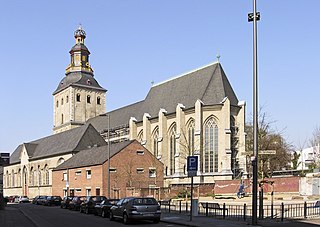
The Basilica church of St. Ursula is located in Cologne, North Rhine-Westphalia, Germany. It is built upon the ancient ruins of a Roman cemetery, where the 11,000 virgins associated with the legend of Saint Ursula are said to have been buried. The church has an impressive reliquary created from the bones of the former occupants of the cemetery. It is one of the twelve Romanesque churches of Cologne and was designated a Minor Basilica on 25 June 1920. While the nave and main tower are Romanesque, the choir has been rebuilt in the Gothic style.
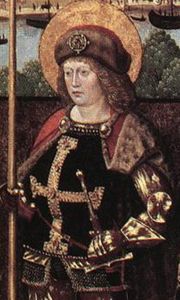
Saint Gereon of Cologne, who may have been a soldier, was martyred at Cologne by beheading, probably in the early 4th century.
Saint Aurelia of Strasbourg was a 4th-century saint, whose tomb in Strasbourg became the centre of a popular cult in the Middle Ages.

The Prince-Bishopric of Basel was an ecclesiastical principality within the Holy Roman Empire, ruled from 1032 by prince-bishops with their seat at Basel, and from 1528 until 1792 at Porrentruy, and thereafter at Schliengen. As an imperial estate, the prince-bishop had seat and vote at the Imperial Diet. The final dissolution of the state occurred in 1803 as part of the German Mediatisation.

The Master of the Legend of St. Ursula (1436–1505) was a Flemish painter active in the fifteenth century. His name is derived from a polyptych depicting scenes from the life of Saint Ursula painted for the convent of the Black Sisters of Bruges. The city appears in the background of a number of the paintings, in which the belfry and tower of the Church of Notre-Dame are visible. Consequently, it is possible, given the stages of construction of the belfry, to determine that the altarpiece was painted either before 1483 or somewhere between 1493 and 1499. The Netherlands Institute for Art History hold his birth and death dates to be those of Pieter Casenbroot, who was registered in the Bruges guild of saddlemakers and sculptors in 1460. Today the panels have been dispersed to a number of museums around the world.
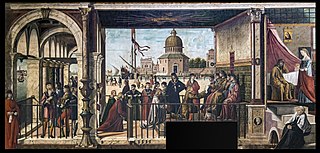
The Legend of Saint Ursula is a series of large wall-paintings on canvas by the Italian Renaissance artist Vittore Carpaccio, commissioned by the Loredan family and originally created for the Scuola di Sant'Orsola (Ursula) in Venice, which was under their patronage. They are now in the Gallerie dell'Accademia in Venice.
Master of the legend of St. Ursula may refer to:

Innenstadt is the central borough (Stadtbezirk) of the City of Cologne in Germany.
The twelve Romanesque churches of Cologne are twelve landmark churches in the Old town (Altstadt) of Cologne, Germany. All twelve churches are Catholic.

Saint Odilia is a Saint venerated in the Roman Catholic Church, although according to the current liturgical calendar, her feast day is not officially commemorated. She is a patroness of good eyesight.

The Shrine of St. Ursula is a carved and gilded wooden reliquary containing oil on panel inserts by Hans Memling. Dating to c. 1489, it is housed in the Hans Memling Museum in the Old St. John's Hospital (Sint-Janshospitaal), Bruges in the Flemish Region of modern-day Belgium.

The Master of the Cologne Legend of St. Ursula was a German Renaissance painter.
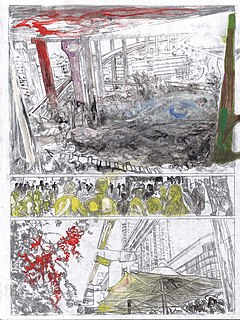
Stefan Ettlinger is a German painter and draughtsman. He studied at the Kunstakademie Düsseldorf at Alfonso Hüppi as a master student. He lives and works in Düsseldorf.
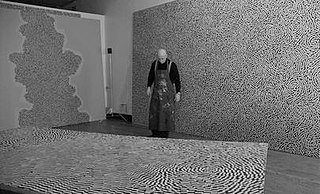
Luca Lazar or Luka Lasareishvili is a Georgian artist. He was born on 14 November 1957 in Tbilisi, Georgia. He studied at the Tbilisi State Art Academy from 1976 to 1982 from which he graduated with a Masters of Fine Arts degree. Since 1982 he has been working as an independent, professional artist and participated in numerous solo- and group exhibitions in galleries and museums. He has worked in a variety of media: painting, installations, object and video art. From 1985 until 1988 Lazar lived and worked in Moscow, Russia. He then moved on to Paris, France. The following year, 1989, Lazar spent in Kassel, Germany as an artist-in-residence with the Museum Fridericianum. From 1990 until 2003 Lazar lived and worked in Cologne, Germany. During his time in Germany, sweeping changes were taking place in his native region that led to the collapse of the Soviet Union, the declaration of independence of Georgia and was followed by armed conflicts and civil war in his country of origin. As Lazar was unable to return, he stayed on in Germany, where he eventually received citizenship. From 1997 until 2005 he held a position as lecturer at the European Academy of Fine Arts in Trier, Germany. In 2003 Lazar relocated to New York City, United States, where he has continued his artistic career.

Katja Wulff, also Käthe Wulff,, was a German-Swiss expressionist dancer (Ausdruckstänzerin) and dance instructor. She attended Rudolf von Laban's dance classes and became associated with the Dada movement. She ran a dance school and was still teaching there at the age of 90.















